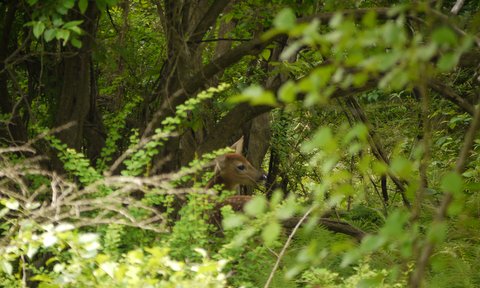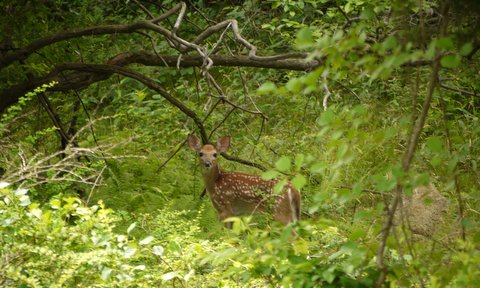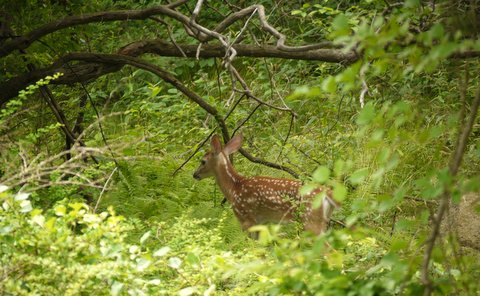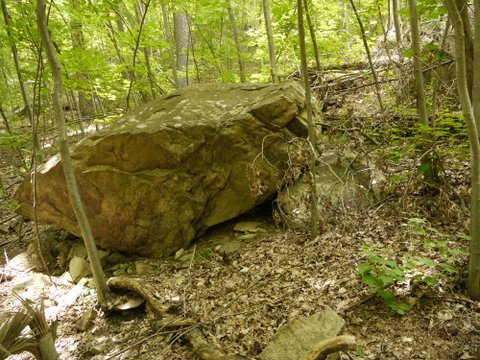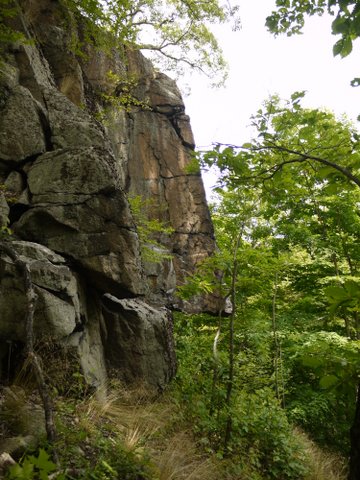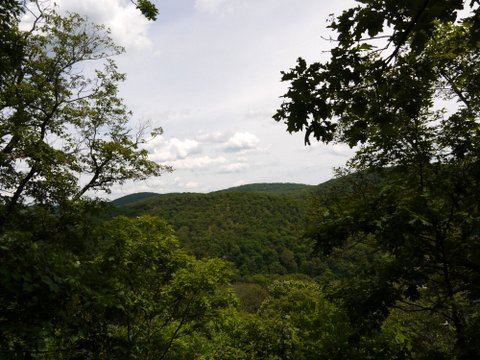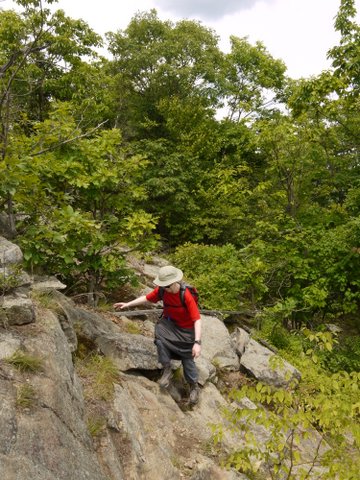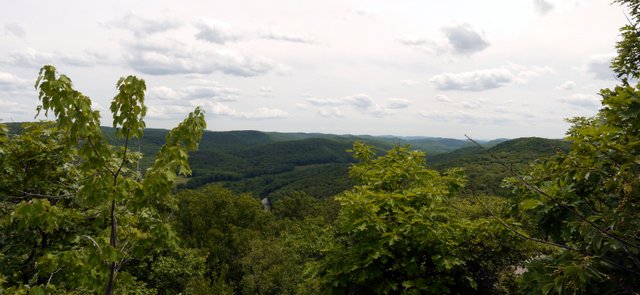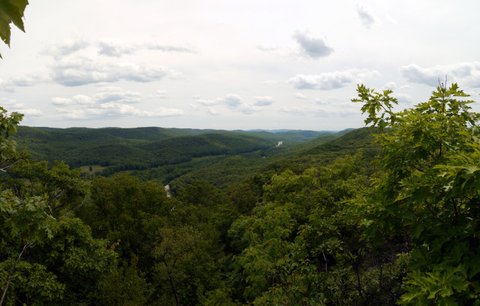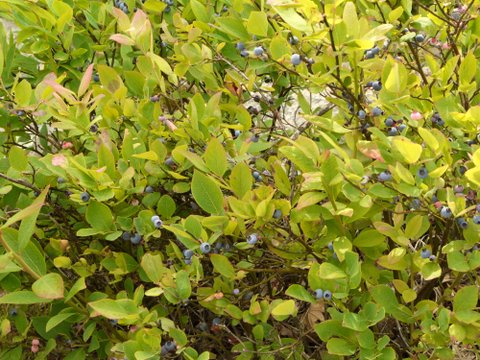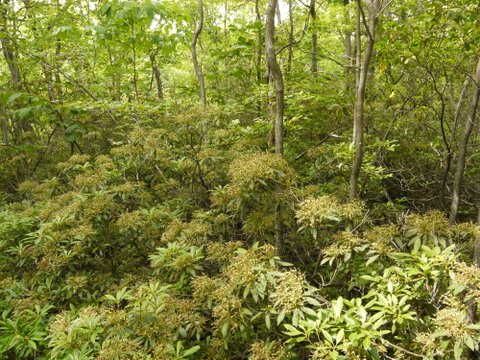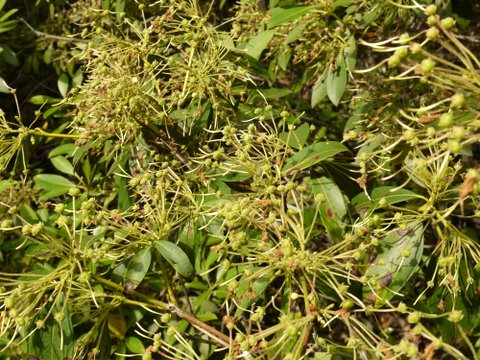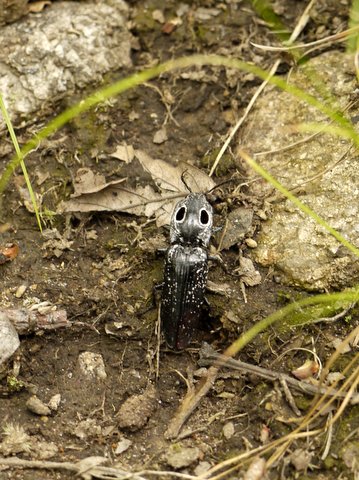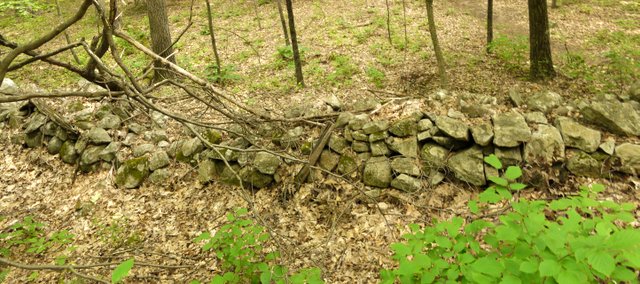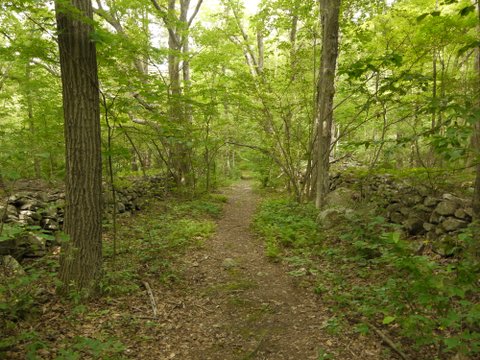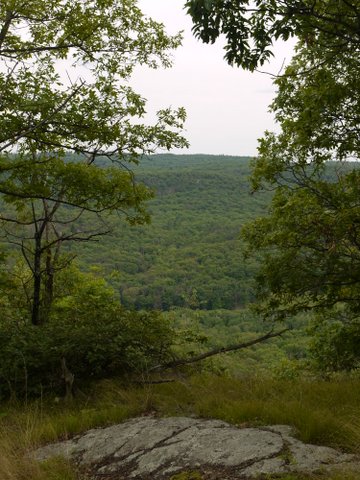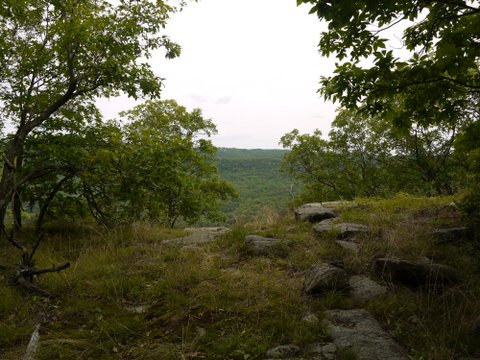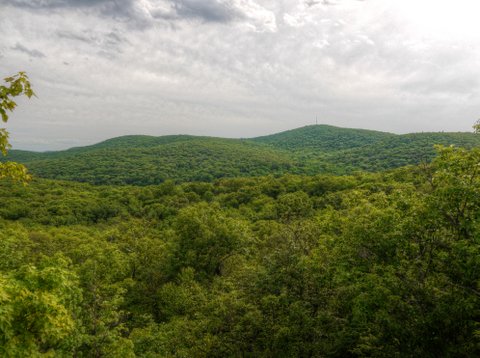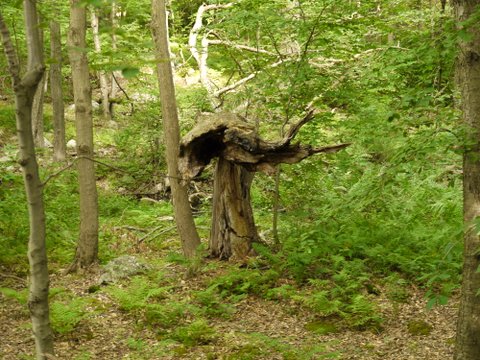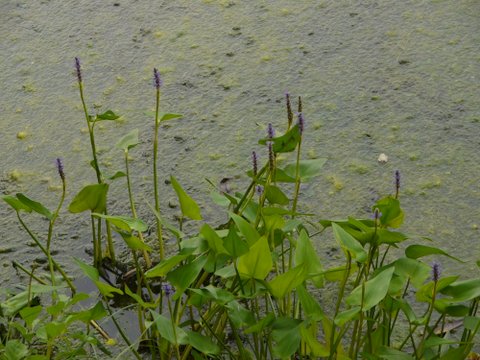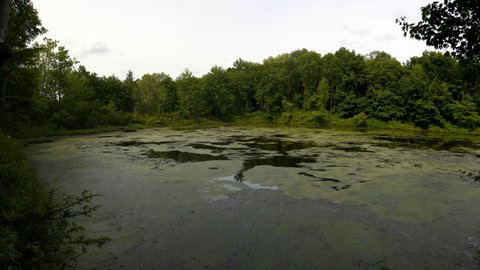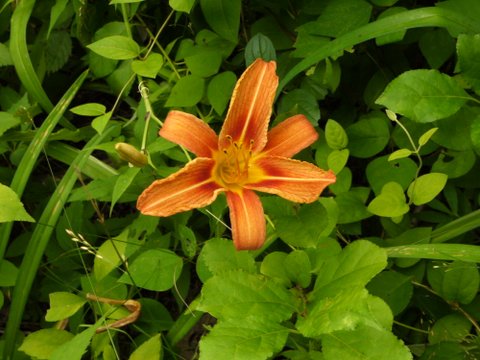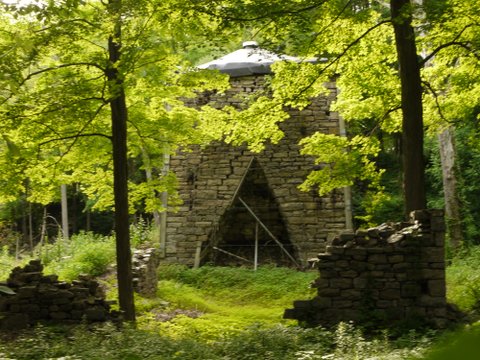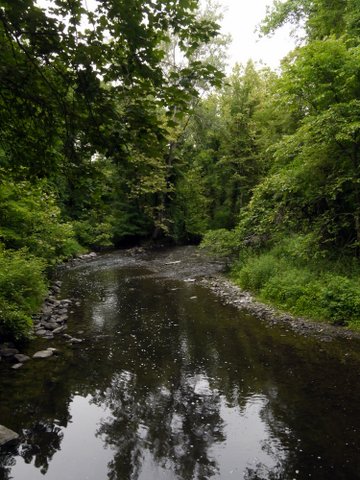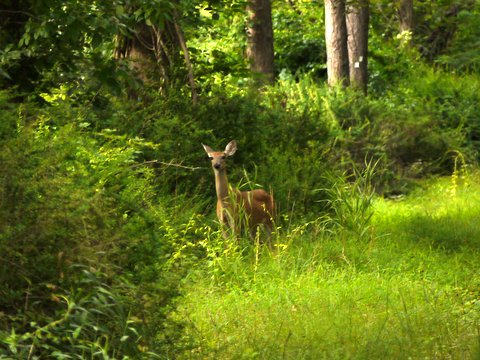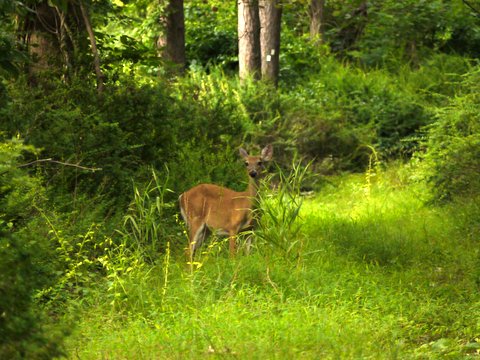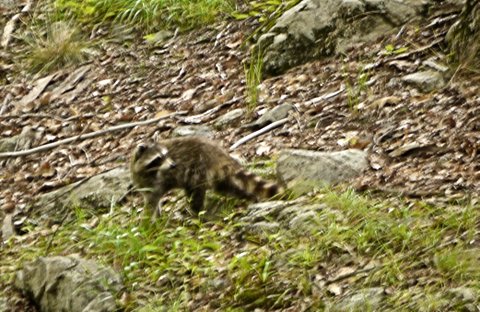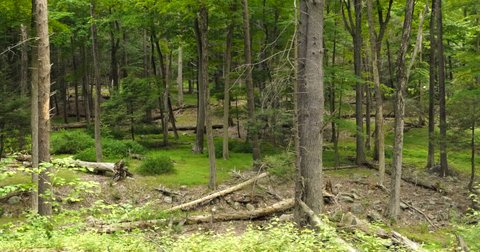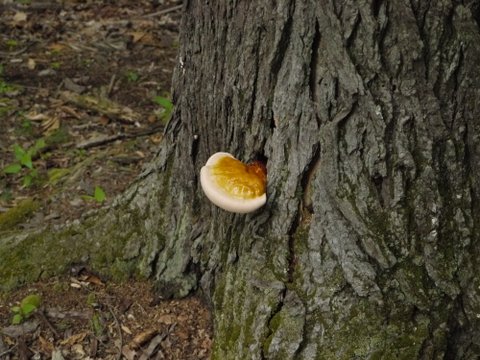This was the third time I completed this particular hike, one of my favorites in the New York area. The first time was a solo hike, On June 12, 2011, and the second time was with friends, on October 14, 2012. This was the first time that Batya had been on this hike.
We began in Harriman State Park, leaving the car in the “Elk Pen” parking area, and walking west along Arden Valley Road. I have seen deer both previous times that I did this hike and today, even before the road crossed over I-87, I spotted a fawn in the woods:
She was not tiny, and therefore I suspect that she was born in May or even in late April, rather than in June:
We crossed over I-87 and then the Ramapo River, and then when Arden Valley Road ended at Route 17, we carefully ran across the highway and entered the woods, hiking northwest (southbound on the Appalachian Trail). The trail quickly gains about 500′ elevation, with part of it called “Agony Grind.”
We were happy to see plenty of greenery, which provided a nice contrast with the rocks and the fallen leaves from the previous Fall:
Some of the cliffs near Agony Grind:
As we gained a bit of altitude, we were rewarded with our first scenic view:
We kept climbing. Here, I have caught Batya in an action shot on one short scramble:
We reached another fine scenic view. My New York-New Jersey Trail Conference map doesn’t indicate any scenic views in this stretch of the trail, but I think this qualifies as one:
We had lunch at this spot, enjoying the view:
I’m not sure which of these stitched panoramas is best, so I’ve included all three:
After enjoying my sandwich and yogurt, I spotted some blueberries, and sampled a couple of them:
We continued hiking west. Here, we found a stand of shrubs that were probably kalmia, maybe mountain laurel (kalmia latifolia). We had seen mountain laurel flowers in Connecticut two weeks earlier, but this stand was not yet in bloom:
A close-up on the shrubs:
We reached the intersection with the blue-blazed trail that led to the Indian Hill region of Sterling Forest State Park, where we found a pair of perfectly good boots that someone had perhaps lost.
We left the Appalachian Trail, turning on the blue trail into Sterling Forest. Here, we encountered a handsome specimen of the eastern eyed click beetle (Alaus oculatus):
The blue trail met the yellow-blazed Indian Hill Loop, and we took the left-hand (eastern) portion of that. Here, we encounter a rock wall:
Even more impressive is when the trail briefly follows an old road that is bordered on both sides by rock walls:
The Trail Conference map does show scenic views exist on this trail:
A stitched panorama of one scenic view:
A tonemapped image:
The stump of a dead tree:
We reached the red-blazed Furnace Loop. We ultimately wanted to turn left to take the southern portion, but diverted a bit to the right (the northern portion) so as to visit the unnamed pond, where I photographed this pickerelweed:
The pond was covered with algae:
We walked along the entire western side of the small pond and continued on the trail, until Batya was kind enough to point out that we were on the yellow-bird-on-green-blazed Warbler Trail. (That would not have taken us terribly far out of the way, but it wasn’t what I had intended.) We backtracked from the pond and returned to the red-blazed Furnace Loop, and followed the southern portion.
The orange daylily (Pontederia cordata) is an Asian species that was cultivated in the U.S. and has escaped to the wild, becoming an invasive species:
We soon reached the remnants of the Southfields Iron Furnace, built in 1805 and rebulit in 1836:
We then left Sterling Forest, walking southwest on County Road 19 (“Orange Turnpike”) which took us back to Route 17. We crossed Route 17, walked east along Railroad Avenue, and then followed the train tracks of the Metro-North Line until we came to the blaze marking the end of Harriman’s Nurian trail. We followed that trail, crossing the Ramapo River:
The trail then took us to a pedestrian bridge over I-87. If desired, refer to my June 12, 2011 post for photos of the pedestrian bridges over the Ramapo River and I-87.
Back in Harriman State Park, we hiked briefly along Arden Road, where we again saw a deer, this time an adult:
As the flat Arden Trail is too overgrown to take it all the way back to the Elk Pen, we had to follow the Nurian Trail up and down a number of hills. On the way, I spotted a raccoon, though I struggled to hold my telephoto lens steady in the lower light levels:
A couple was hiking toward us, asking if we had seen the red-blazed Stahahe Brook trail, which we would also want, to take us back to the Elk Pen parking area. I told them that it was behind them, so they turned around and walked with us toward the east. We still had over an hour before sundown, but it would not have been a good time to be lost in the woods, so I am glad that we were able to help them.
Here, I took another stitched panorama, of fallen trees:
Another area was very green:
We finally found the intersection with the Stahahe Brook trail. While it shows on my map as red-blazed, it is actually blazed as a (very) thin red horizontal stripe against a white background. Thus, it did not offer much contrast with the white-blazed Nurian trail that we were following. I can understand that the other couple missed their turn, as I first took it to be an intersection with a second white-blazed trail, before spotting the very thin red stripe.
Red-Belt Conk grew on an old tree trunk:
A clearing appeared, not far from the end of our hike:
We returned to the Elk Pen, and the couple again thanked us for helping them with the directions. It was a fun hike, and I was happy to have experienced it for the third time. I don’t know if there are always deer there, or if I have just been lucky to have seen them on every visit.

